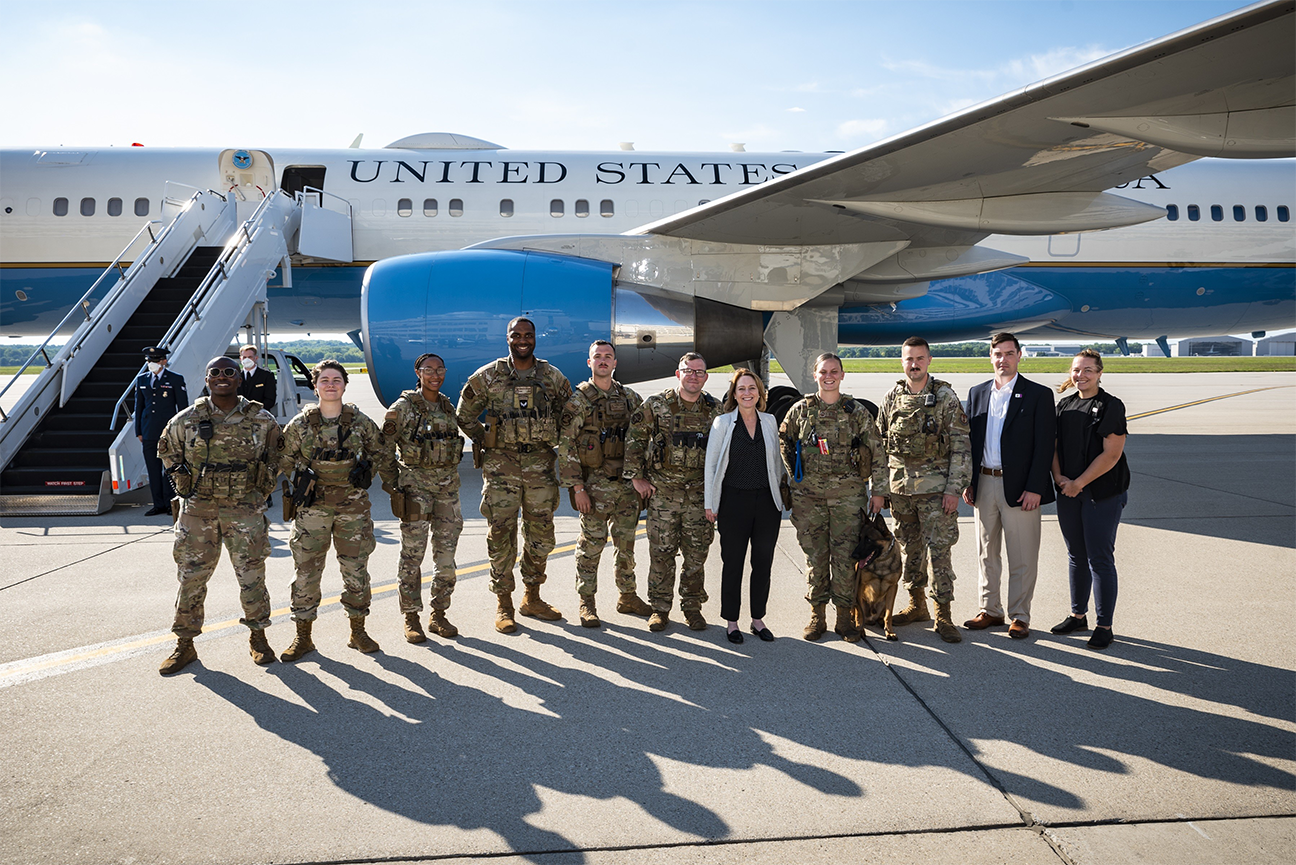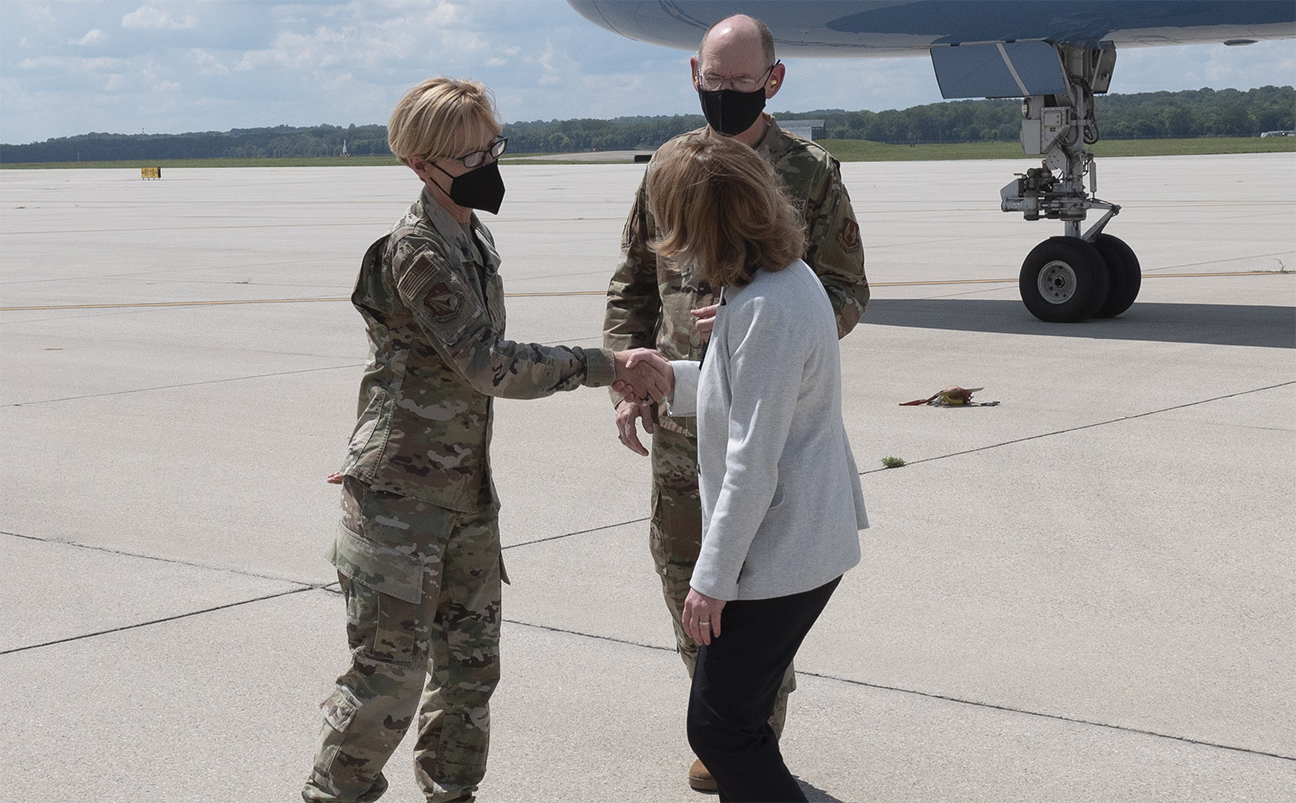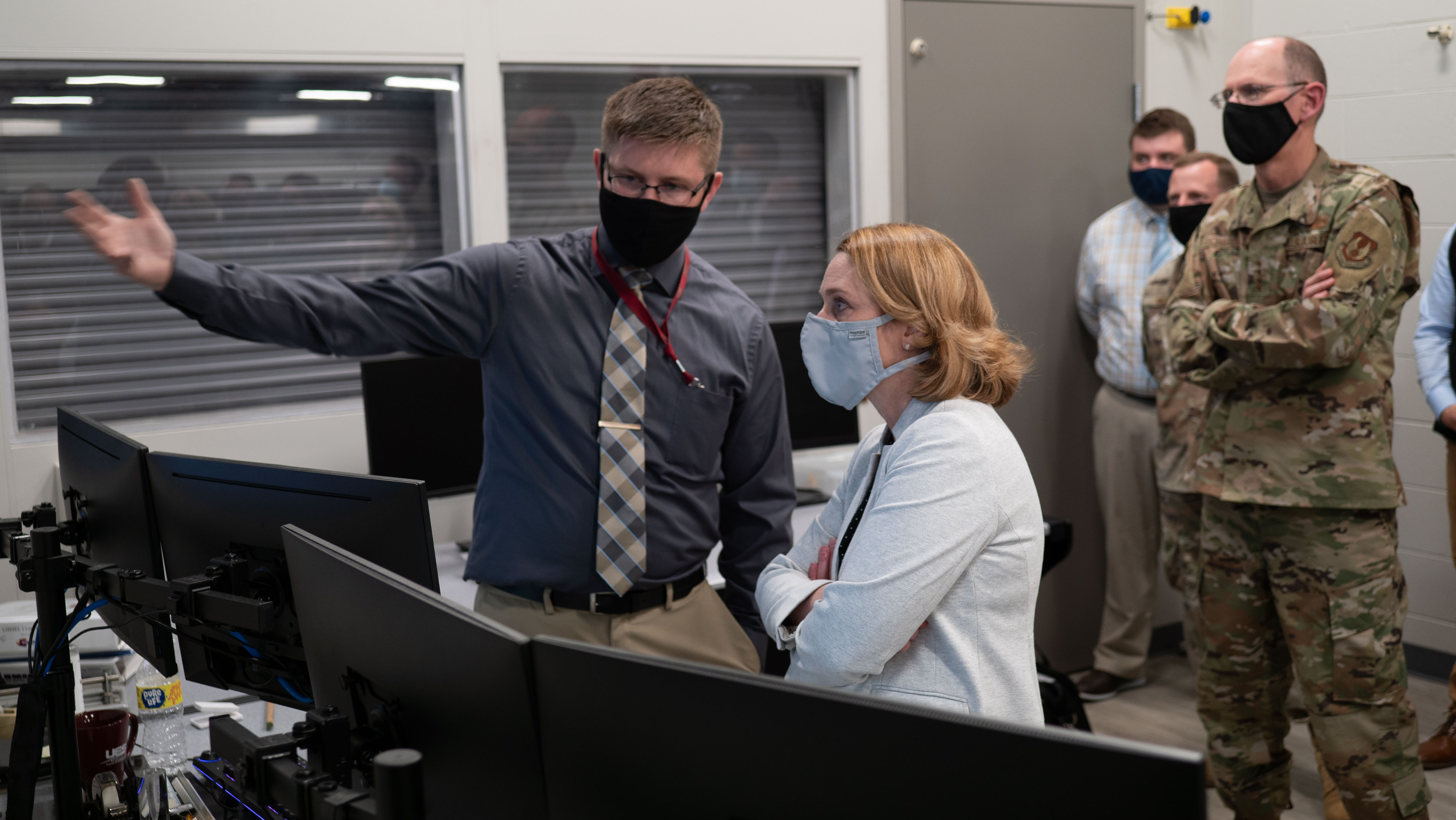WRIGHT-PATTERSON AIR FORCE BASE, Ohio (AFRL) — Deputy Secretary of Defense Dr. Kathleen H. Hicks traveled to Wright-Patterson Air Force Base, Aug. 17, 2022, where she visited an Air Force Research Laboratory thermal materials testing facility and was briefed on key areas including counter-directed energy weapons development, opportunities and challenges; AFRL priorities, including the lab’s science and technology portfolio and workforce development programs, such as AFRL’s human capital strategy.
Hicks, who praised the “U.S. innovation ecosystem advantage,” commended “research communities, government and industry” for “going after issues that are facing the warfighter and delivering results.” She said, “capability advances that [AFRL scientists and engineers] are taking at the research level are paying off and will pay off as we look at potential adversary use.”
Gen. Duke Richardson, commander of Air Force Materiel Command; Maj. Gen. Heather Pringle, AFRL commander; and Timothy Sakulich, AFRL executive director, hosted Hicks along with U.S. Space Force Chief Technology and Innovation Officer Dr. Lisa Costa.
“AFRL’s scientists, engineers and professionals have been busy and there’s so much going on,” Pringle said. “Hosting DepSecDef was the perfect opportunity to highlight AFRL’s contributions to the DOD’s strategic competition priorities.”
Hicks and Costa toured AFRL’s Laser-Hardened Materials Evaluation Laboratory, a nationally unique research and development facility that specializes in laser and materials interaction testing. Part of AFRL’s Materials and Manufacturing Directorate, the lab provides the aerospace community with high-temperature characterization of current and emerging materials, delivering data to U.S. Air Force, U.S. Space Force, DOD, NASA and industry customers.
AFRL researchers presented fielded capabilities to Hicks, including a solution for laser eye protection that Washington State Patrol pilots successfully tested. Dr. Matt Lange, who leads AFRL’s Personnel Protection Team, demonstrated Commercial Aviation Low Intensity, or CALI, glasses that protect pilots from blinding laser attacks by filtering laser light without interfering with the light coming from the pilot’s instrument panel.
News media representatives travelling with Hicks also discussed the AFRL Regional Research Hub program with Brian McJilton, director of the AFRL Small Business Directorate, and Dr. Richard Vaia, chief scientist of AFRL’s Materials and Manufacturing Directorate. This pilot initiative, currently establishing regional research networks in the Midwest and Mid-Atlantic, aims to connect innovative AFRL research with regional innovators to leverage ecosystems and accelerate technology translation that ultimately impacts defense and commercial markets.
McJilton said workforce development is crucial for future competitive advantage, and this initiative will equip civilian and military members with unique experiences outside the lab, as well as deepen and broaden partnerships and expand access to key talent.
“We are working a lot of hard problems that are critical to our nation’s defense,” Vaia said. “If we can continue to raise visibility of what AFRL has and what we do, that is a long step toward setting ourselves up for what we need to do in the future by being able to attract collaborative partners.”
AFRL, designated as a DOD Science and Technology Reinvention Laboratory, continues to pursue new flexibilities to attract, hire, compensate and retain talent in an increasingly dynamic and competitive talent market.
Hicks also discussed sustainment challenges and opportunities being addressed by AFMC with Richardson during the visit. AFMC is leading several initiatives supporting supply chain resiliency, aircraft fleets and organic industrial base health.
Hicks, who has served as the chief operating officer for the DOD since 2021, also visited the Department of Energy National Lab in Oak Ridge, Tennessee; U.S Transportation Command at Scott Air Force Base, Illinois; and Purdue University in West Lafayette, Indiana, during a two-day, four-state tour of the Midwest. Throughout her travel, she focused on linking the department’s resources to strategic competition priorities, including the pacing threat of China.
“In order for the U.S. to defend itself, we have to be able to develop capabilities that leverage innovation and make changes that keep us ahead of those threats,” Hicks said. “My job is to make sure we can connect [the Secretary of Defense’s vision] to the outcomes of the Department and deliver to the warfighter and to the taxpayer what they expect.”
About AFRL
The Air Force Research Laboratory (AFRL) is the primary scientific research and development center for the Department of the Air Force. AFRL plays an integral role in leading the discovery, development, and integration of affordable warfighting technologies for our air, space, and cyberspace force. With a workforce of more than 11,500 across nine technology areas and 40 other operations across the globe, AFRL provides a diverse portfolio of science and technology ranging from fundamental to advanced research and technology development. For more information, visit: www.afresearchlab.com.

88th Air Base Wing Security Forces defenders pose with Deputy Secretary of Defense Dr. Kathleen H. Hicks, who visited Wright-Patterson Air Force Base Aug. 17, 2022. (Department of Defense photo / Lisa Ferdinando)

Air Force Research Laboratory Commander Maj. Gen. Heather Pringle and Gen. Duke Richardson, commander of Air Force Materiel Command, greet Deputy Secretary of Defense Dr. Kathleen H. Hicks, who visited Wright-Patterson Air Force Base, Aug. 17, 2022. (U.S. Air Force photo / Keith Lewis)

Air Force Research Laboratory Program Manager and UES, Inc. Contractor Braden Childers, left, discusses thermal materials testing inside the control room of AFRL’s Laser-Hardened Materials Evaluation Laboratory with Deputy Secretary of Defense Dr. Kathleen H. Hicks, who visited Wright-Patterson Air Force Base, Aug. 17, 2022. Gen. Duke Richardson, commander of Air Force Materiel Command, watches the demonstration. (U.S. Air Force photo / Keith Lewis)

